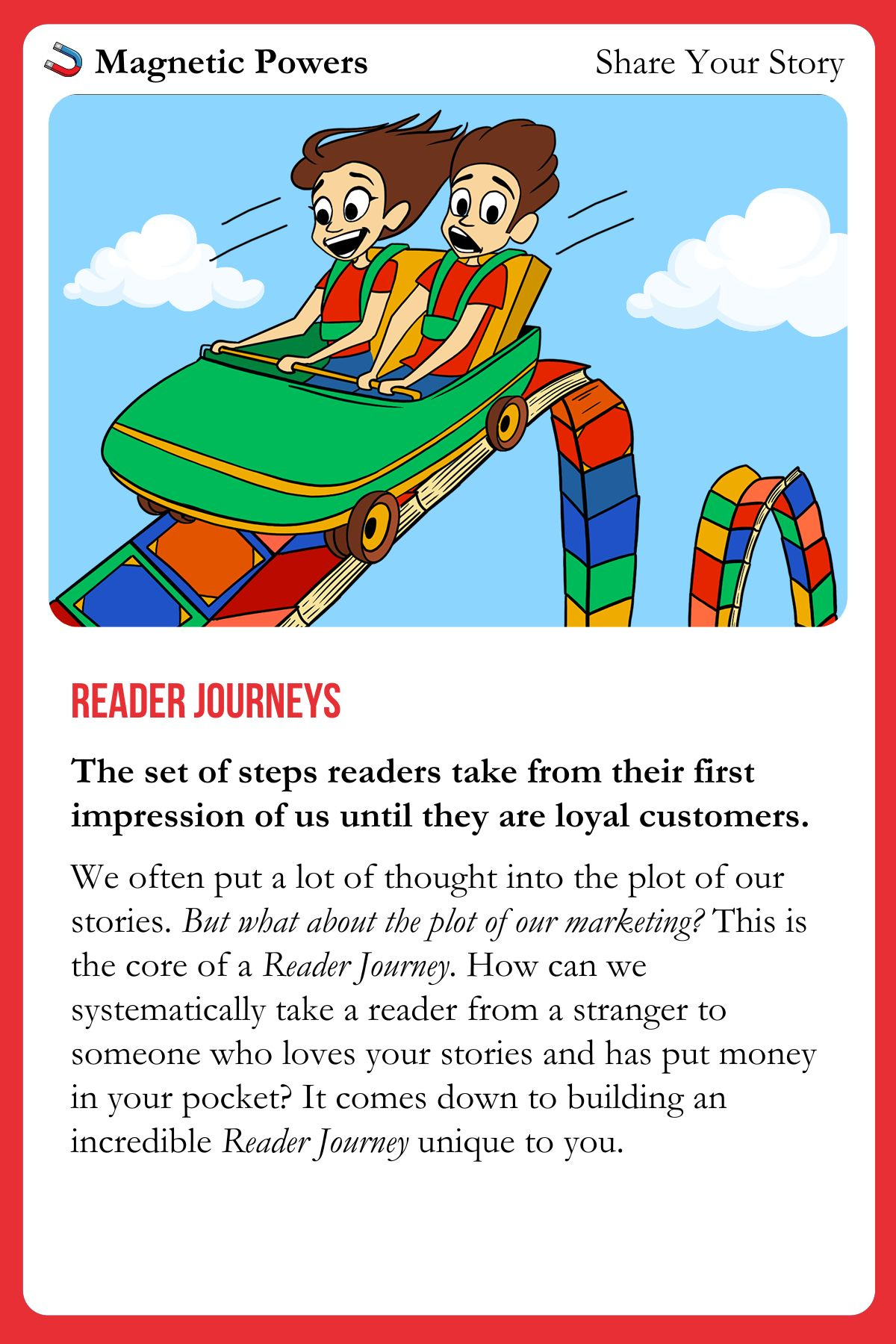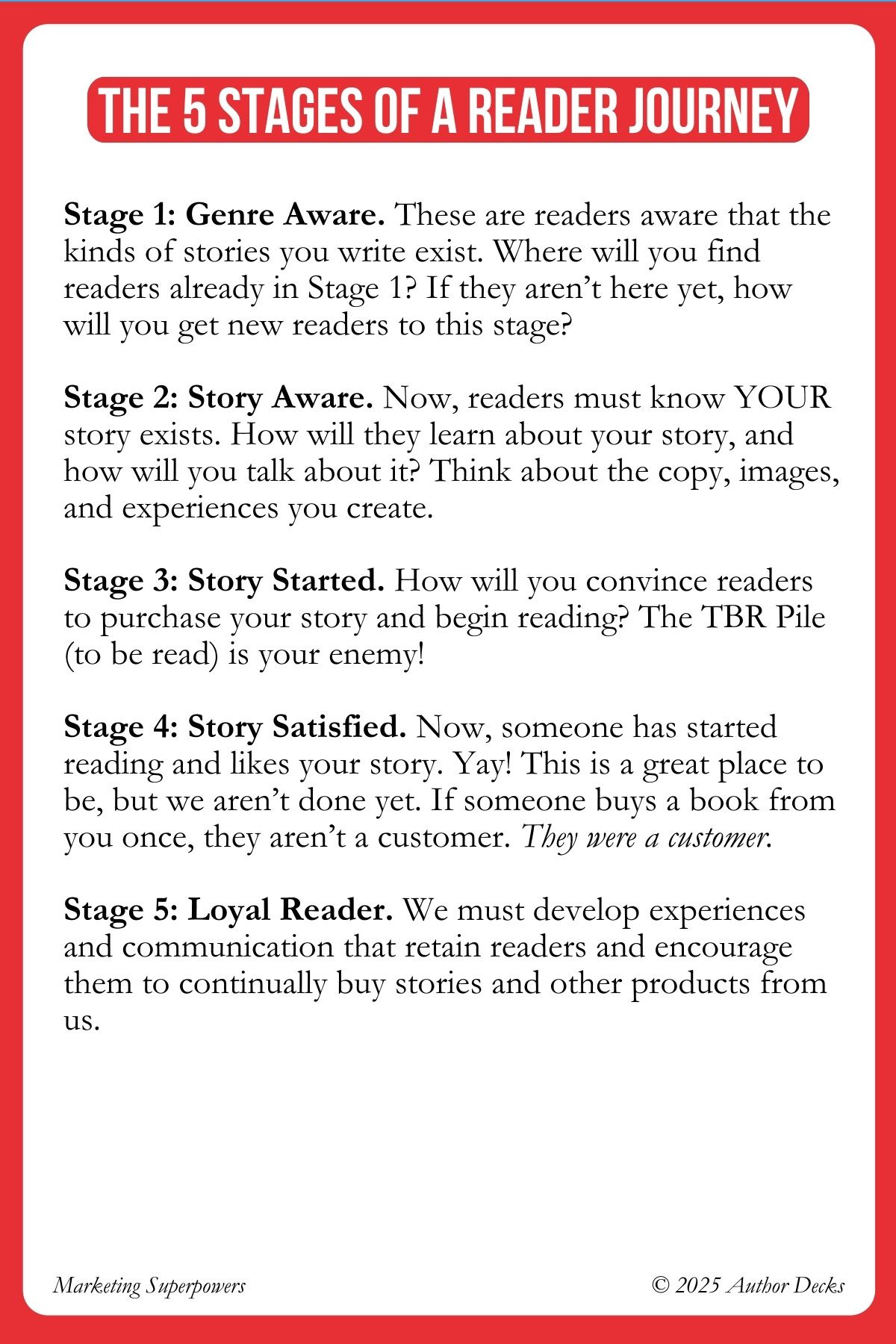First, I’ll be hosting Story Suppers in London, Manchester, Dublin, and Birmingham over the next 7 days.
Story Suppers are meet-ups of writers in your local city for dinner. They are small, intimate gatherings and free to attend (you just cover the cost of your food).
You can RSVP to attend here (scroll down to see all of the current Story Suppers):
Now onto Cultural Relevance vs. Contextual Relevance 👇
Your Readership is 10x Smaller Than it *Should* Be
So often, we fight over the same pool of readers.
The readers who are already subscribed to Kindle Unlimited.
The readers who are already members of newsletters from authors in our genre.
We speak in code in our marketing.
If you like “insert X book” or “insert Y book” then you’ll love my book!
But wait— isn’t this what you should be doing?
Well… yes. Yes! This is great marketing. In fact, I’ve shared about this a ton inside the 50 Author Marketing Superpowers and even more in my article on Smallest Viable Readership.
But here’s the thing: whenever you are marketing to readers who are already aware of your genre/the types of stories you write, you are artificially constraining your readership.
This is because your marketing is solely focused on having your stories gain Contextual Relevance.
Contextual Relevance is when readers become aware of a specific product, service, or story you offer. Of course, you don’t want to be sharing your story with folks who never read. Your conversion rate will be way lower, and generally, the context of your story won’t have as much immediate value to them, leading to your marketing being less effective.
All of this is true.
But it also misses a huge part of the picture.
In my last podcast, I talked about Publishing Boundlessness. The idea that our future as authors will be much better than today, despite the challenges we will continue to face.
A big part of how we can work together to make the future of our industry brighter than ever is by growing the overall audience that is interested in the types of stories we write.
There’s no magic pill to suddenly have 10x more people regularly reading books.
But there is an incredible marketing strategy that you probably spend 0% of your time on. And just devoting a small portion of your marketing efforts to this can increase your readership by leaps and bounds over the long run.
This powerful strategy, my storytelling heroes, is Cultural Relevance.
What is Cultural Relevance?
Cultural Relevance is when you create content, a brand, or a community that interests as broad a group of people as possible.
Working for MrBeast, I saw the power of this strategy from the inside.
They don’t even consider themselves a media company. They are a virality company, interested in creating maximum cultural relevance for the brand.
This often means going a mile wide and an inch deep.
But that’s the point.
By casting as wide a net as possible, you build a top of funnel that can allow you to create multiple products and stories that serve different audiences and interests that your cultural relevance allows you to reach.
In the case of MrBeast, he has software that serves video creators (Viewstats), lunch kits for kids (Lunchly), and chocolate for people who care about ethically sourced supply chains (I feel like almost everyone loves chocolate? 😅).
And it’s not just MrBeast who has achieved cultural relevance at scale (although arguably no one has achieved greater cultural relevance except for Taylor Swift… she’s absolutely the Queen of this).
Reading creators like Jack Edwards, Haley Pham, and Morgannbook have millions of followers each to hear them talk about books and the lifestyle of reading.
They make reading “cool”, bringing more readers into the industry across all genres. They can now write books in a multitude of genres, knowing that they have achieved broad cultural relevance in the world of reading. And cultural relevance doesn’t have to be with just readers.
You can build cultural relevance with basketball fans, horse lovers like Natalie Keller Reinert (she regularly markets her books at horse conventions), or folks who love military aviation like James Blatch. When you start with Cultural Relevance and make it a key part of your long-term marketing strategy, you can build relevance way beyond your genre to help you sell more books than you ever could have otherwise — and expand into other products and services beyond the book.
This is an empire.
So if Cultural Relevance is so powerful, how do we unlock it for ourselves?
The Reader Journey Superpower
First, understanding the Reader Journey Superpower is essential (you can get all 50 superpowers for free here).
As you can see, so much of our marketing is focused on bringing readers from Stage 1 to Stage 2 and ideally to Stage 3 and beyond.
Candidly, I think we need to do a much better job at bringing readers from Stage 3 to 4 and 5, but that’s an essay for another day.
Our focus today is on something much more foundational.
If there are no readers in Stage 1, then we will have a very difficult time moving anyone from Stage 1 to Stage 2.
Our goal with cultural relevance is to grow the number of people who are Genre Aware (Stage 1) and radically increase the “top of funnel” for our marketing.
And to become culturally relevant, we must unleash the power of virality.
The Key to Creating Virality
When something goes viral, it’s because people share it with each other at a higher rate than is typical.
Everyone’s benchmark for virality is different. At MrBeast, our benchmark for virality increased over time. At one point, 10 million views on a video were good. Now, 50+ million views in 24 hours is closer to the benchmark for something that is truly viral by Beast standards (and hundreds of millions of views over the course of a few years).
It takes a ton of time to get anywhere close to that level of virality (for many reasons, I’m not confident anyone will ever go more viral than MrBeast, but that’s a conversation for another day).
It’s hard to engineer virality to perfection. Every creator, even the best in the world at going viral, has pieces of content that flop.
However, the best creators go viral much more often than average.
Here’s the framework they use to grab as much Cultural Relevance as possible and convert it to Contextual Relevance at a high rate.
You can use this too.
Across any media format.
It can be a podcast. It can be a TikTok video. It can be a Facebook Ad.
It can even be your book cover and description.
First, brainstorm hooks.
Whether it’s a story idea/premise or a new headline for a Facebook Ad, begin writing down things that interest you.
The goal is to have no filters here. Be messy. It’s okay if a lot of your ideas are “not good”. You just need one idea to go viral!
The key here is not to think about how to frame your ideas. Think about the meat of the content. What is this about, and why will it matter to people?
The next step is where we start to make magic happen.
What is the core, casual, and new version of that hook? Then go with the “new” version of that hook.
Views maximization is the idea that by shifting the packaging of your content (story or advertisement), you can get more people interested.
Views Maximization is especially powerful when we are thinking about gaining cultural relevance.
Divide the people you could potentially reach into 3 categories:
Core: These people are already fans of you and your stories, or are super fans of the kinds of stories you write.
Casual: These are people in Stage 1 of the Reader Journey. They are genre aware, but may not even be actively reading any books similar to yours. Think of them as aware of the market and interested, but by no means are they geeking out about it with their friends on the weekend.
New: These are people who have no idea about the types of stories you write. Maybe they have heard it in passing, but they are totally new entrants to the market.
Framing hooks so they are attractive to new people in your market is the key to gaining cultural relevance. Think from a Readers First perspective: how can you interest people who don’t even read that your story is amazing?
For example, instead of “here’s a book for spicy romance lovers where a heartbroken man hires a professional memory editor to erase memories of his ex, but the memory editor falls in love and inserts herself into his memories”.
Try: “I edit memories for a living, and I made a massive mistake. Heartbroken men come to me when they want their ex erased from their past. The problem? I fell in love with one of my clients. And I inserted myself into his memories.”
Why is the second version better? It used a conversational tone, relatability, and has more emotional tension. We’ve all seen TikToks similar in nature to this that go viral! For fun, I encourage you to post both versions on TikTok as scripts for your video and let me know what gets more views! It’s a fun experiment— and exactly the kind of experiment you should be running in your marketing.
Even this kind of marketing is still limited in its view of Cultural Relevance. What if you created short form videos (the best place to gain virality right now) targeted to a broader audience that don’t even mention your stories but build awareness of your brand?
Writing spicy romance? Think about the endless stories, advice, and more you can share with people online.
Writing science fiction? Think about all the new technologies and research impacting our future that you can share.
Writing mysteries? Think of all the real-life mysteries and cold cases you can highlight.
And every single one of your hooks and premises for this content can be designed to get as many views as possible by being tailored to NEW viewers.
Content framed to a new audience versus a core audience has the potential for 100x more reach and exponentially greater cultural impact.
Now I can’t take credit for this framework of Core, Casual, and New. That belongs to Paddy Galloway, a top YouTube Strategist.
But I’ve seen the power of this framework in action. And I encourage you to use it to make any marketing you do as an author more culturally relevant. In fact, you can just take this framework and study why YouTube videos, books, TikTok videos, and more gain tons of viewership.
As a bonus, people want to pay attention to and share things that evoke the emotion of awe. How can you awe people and gain cultural relevance? A great book all about this is Audacious by Mark Schaefer.
And that’s it for this one.
Let me know your ideas to frame content and story premises for a new, casual, and core audience. There are benefits to all— think a newsletter being focused on language that appeals more to core fans!
I’ll be back soon with another episode of the Beyond the Book Podcast.
In the meantime, don’t forget…
Together we are boundless,
Michael Evans
The Author Sidekick




I’m reading Audacious now. Almost finished it. I’ve been taking tons of notes in light of my publishing/writing goals. Great post!